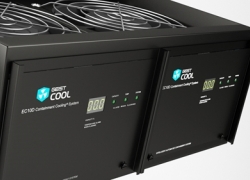Temperature monitoring systems increase equipment reliability
Temperature monitoring systems increase equipment reliability

Data center reliability depends on many factors. These can include equipment functionality, static temperature and humidity and quality facility administration. Equipment reliability is especially important, because the average cost of downtime continues to rise, and machine failure can wreak costly havoc on unprepared companies. In 2013, a study published by the Ponemon Institute found that the overall average cost of data center downtime is $627,418 per incident, and IT equipment failure is the most expensive cause.
In order to ensure minimal unplanned downtime or costly outages, it's important to make sure all the pieces of the puzzle come together to paint a picture of reliability in the data center. Server room cooling, especially, is an important aspect of making sure equipment continues to function at high operating levels. Overworked and overheated equipment has a traditionally shorter lifespan, and it's expensive to repeatedly replace servers and racks.
Server room cooling has grown and evolved over the years as data centers have become larger and more dense. Facility operators understand the importance of achieving a cool airflow and making sure equipment remains at a proper temperature to optimize server functionality. According to DatacenterDynamics contributor John Collins, it's imperative that companies design their data centers with cooling in mind. This means they should base the layout of the room on the racks they need to ensure proper environment monitoring, instead of the room-then-rack way it has traditionally been done.
The dangers of inefficient cooling
According to TechTarget contributor Bill Kleyman, servers and server racks need to remain below a maximum inlet temperature. When servers overheat, outages can occur. Strict temperature monitoring is required in order to realize issues before they become serious data room problems. Re-circulation of old, hot air can occur if cooling systems aren't designed and implemented properly - this recycling of hot exhaust air can heat IT equipment to dangerous temperatures.
Monitor the whole rack
One of the most efficient ways to ensure data center reliability is to install monitoring equipment in the server room. The Data Center Journal reported that an imbalance in temperature in one portion of a cabinet could create hot spots in the server room, and cooling systems have to work harder across the board to make up for the imbalance. This could lead to shorter server and cooling equipment life, as overworked systems will have more problems in a shorter period of time. However, when the top, center and bottom of the rack are monitored for temperature and humidity, hot spots become easier to detect, mitigate and manage.
The positives of containment systems
Airflow containment strategies help increase cooling efficiency, which in turn positively affects equipment reliability.
"Designed to organize and control air streams, containment solutions enclose server racks in sealed structures that capture hot exhaust air, vent it to the CRAC units and deliver chilled air directly to the server equipment's air intakes," Collins said.
Total containment of servers means that re-circulation occurs less, which leads to fewer equipment malfunctions due to overheating or humidity issues. Effective monitoring systems like those offered by Geist make airflow management easier. Climate monitors that use special temperature sensors allow IT administrators to keep their eyes on critical equipment at all times, and the Unity Cooling System delivers air to the CRAC units only so much as the data center requires, eliminating potential energy waste and maximizing airflow. Data center functionality depends on physical servers and server racks - when companies make cooling their top priority, it helps to ensure the reliability of equipment and minimizes downtime.



